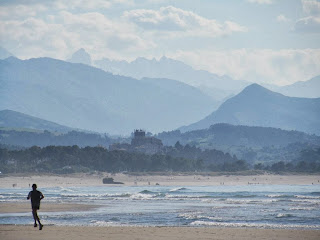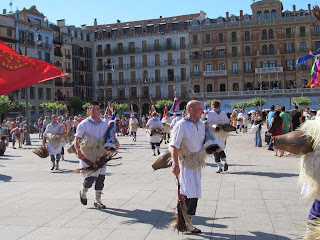Santiago de Compostela
From Portugal
we travelled north west into Spain to visit Santiago de Compostela.
During our years in France
we travelled over several routes which led to Santiago
coming from south Germany
through the Vosge mountains, from the north east of France
through the towns to the south and from Holland
through Utrecht .
It was nice to finally see where the paths finished.
On the way there we passed many walkers and
cyclers of many nationalities. Once in Northern Spain
the route wanders in and out of small villages then onto the main road which is
marked so motorists are aware of the walkers.
We walked around and were
amazed at the huge number of walkers and cyclists of all ages.
The Square was crowded with
people arriving all the time. This guy was exhausted and so was his dog.
This is where they come.
Most of the people coming here
have a shell on them somewhere.
There are rules for doing a
pilgrimage to Santiago ,
the walkers must walk for the last 100 kilometres and cyclists the last 200
kilometres. Ten groups out of the 12 we spoke to had walked or cycled all the
way taking several months to do thousands of kilometres.
We met this couple at the
caravan park, they had cycled from north Holland .
She said her first stop today was to buy some new clothes as she had been
wearing the same two outfits for three months.
From Santiago de Compostella we
went further North.
A Coruna
In the year 61 BC Julias Caesar
reached A Coruna. The Tower of Hercules was built in the 1st century to
guide boats sailing towards the British Isles .
It is the only lighthouse of Antiquity that is in operation tody. The original
lighthouse had a ramp around the outside so horses could take the wood up for
the fire beacon. The light house today was built in 1788 around what remained
of the Roman lighthouse. The memory of the outer ramp is in the form of an
ascending diagonal band that forms a continuous line from top to bottom.
San Vincente de la Barquera
It was time to head east and our overnight stops were usually by the coast. One night we stopped at San Vincente de la Barquera with a group of surfers on top of a cliff. There were 10 vehicles and 8 nationalities; we had a good fun night.
It was time to head east and our overnight stops were usually by the coast. One night we stopped at San Vincente de la Barquera with a group of surfers on top of a cliff. There were 10 vehicles and 8 nationalities; we had a good fun night.
To get to the beach one walked
down a steep path to the water. Kevin went for a swim and I just walked down. It
is much easier in Scarborough to have a surf.
It is always
amazing to us from the flat side of Australia to see Ocean with
extensive mountain ranges so close. This
is the Pico which is very popular for hiking.
We met this young couple and
stopped for a chat. They were walking to Santiago from Holland
with their dog who had special panniers and carried the sleeping bag
sheets. He carried 2 kilo and looked
like he was enjoying the walk.
Tapia Casariego
Another town we stopped in was
Tapia Casariego, a beautiful fishing village and also known for its surf.
While walking back to our campsite a different
way we came across this shop but it wasn’t open so we couldn’t find out the
connection.
This is Basque Country and the
signs are in two languages which means the navigator must pay attention or the
driver gets tetchy, ie “Why cant you understand the sign? . You know
everything”.
As we passed through this town I
thought these houses must cause problems if you came home a little under the
weather. Uhmm!! which one in mine!!
The coast is still very rocky
as we made our way to Bilbao .
This campground has a fantastic view over the Atlantic .
We called into Bilbao to see the Guggenheim Gallery. Well
actually, the building as Modern Art is not Kevin’s thing. What a fantastic
building.
I think the floral cat had the most admirers.
It was made from living plants with an automatic watering system tucked inside.
Now off to Pamplona
our last city in Spain .
We saw this sign in another town in Northern Spain and guess this is another one of the towns.
We had a great time in
The route is all on cobble stone streets, around sharp corners with some roads having wooden railings to
jump behind and others having no cover at all. A lot of shops are selling the white trousers and shirts with the red accessories, a sash or a bandanna, apparently a requirement for running. I bought the scarf just in case we decided to stay here longer. The whole run only takes about 2 minutes, maybe we could last that long.
We learnt that the uphill run is the most dangerous as the bulls have shorter front legs than the back and makes them more powerful running up the hill. Lucky I found this out as I would have decided to run uphill if I was going to run with the bulls.
We learnt that the uphill run is the most dangerous as the bulls have shorter front legs than the back and makes them more powerful running up the hill. Lucky I found this out as I would have decided to run uphill if I was going to run with the bulls.
The Encierro museum was fantastic with historical photos and videos. It also has a simulator so one can try running to a video and a taxidermied bull. My are they huge! Once you see the size of the bull and the videos it is a wonder anyone runs with the bulls.
After the bulls run through the
streets they end up in the stadium where they wait unknowingly until they face
the matador that afternoon to be dispatched with a sword in the neck after
being weakened by several sharp knives in their hide, or if they are lucky
maybe they will dispatch the Matador. Several years ago we went to the
bullfights in Madrid
and spent the whole afternoon watching the gruesome spectacle in the hope that
the bull would win.
After wandering through the
streets we tried the Tapas and wine in a couple of bars then made our way home
quite late at night. I did have some great photos to put in here but somehow a
gremlin or maybe it was the wine made them disappear from my camera.
I do have this photo of us in our runners costume but we decided not to dirty or bloody it by running.
The next day we had a lucky
escape. Not from a bull but from extra zealous parking police. We were camped
overnight in the wrong place. Thank goodness they woke us up at 7 am to tell us
to move which we did promptly. Another motorhome wasn’t so lucky they ignored
the warning and wheel clamps were put on that one.
Still in the mood to look
around we heard there was to be a fiesta and march so back into town we went.
It was the 500th anniversary of Spain
taking over the country of Navarre
and had a great time watching the march.
The police were in abundance but all seemed pretty peaceful.
The red banners were from each
town in what was Nafarroa or modern day Navarre .
And the crowd got restless and
when we started to get surrounded we thought we had better get out of there.
Then we headed back through France to Calais and onto the ferry back to the UK.









































No comments:
Post a Comment